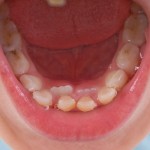
Caries affects the primary teeth of hundreds of millions of children worldwide. Traditional the proximal surfaces of primary molars have been restored with amalgam, but its use is reducing in favour of broad range of tooth-coloured filling materials.
The aim of this review was to compare the success rate of five tooth-coloured materials for class II primary molar restorations.
Methods
Searches were conducted in the Cochrane Library, Medline/PubMed, Scopus, Virtual Health Library and Scopus databases. Randomised controlled trials (RCTs) reporting failure rates of class II restorations in primary molars restored with Glass ionomer cement, GI, Resin-modified glass ionomer cement, RMGI, High-viscosity glass ionomer, HVGI, Composite resin, CR, polyacid-modified composite resin, PACR, compomers were considered. Two reviewers independently selected studies extracted data and assessed studies using the Cochrane risk of bias tool. The primary outcome was clinical success with meta-analyses being performed to evaluate the failure rate of the five two tooth-coloured materials.
Results
- 10 RCTs involving 491 patients (1023 restorations) were included
- Studies were conducted in Brazil, Greece, Israel, Sweden, Turkey, and the UK.
- All the studies were considered to be at high risk because of difficulty in blinding outcome assessment.
- 6 RCTs contributed to the meta-analyses with no significant differences seen between the materials compared (see table).
| Comparisons | No. of studies | Risk ratio (95%CI) |
| CR v RMGI | 6 | 1.10 (0.74 to 1.63) |
| CR v CO | 3 | 1.12 (0.41 to 3.02) |
| CO v RMGI | 3 | 1.04 (0.59 to 1.84) |
Conclusions
The authors concluded: –
CR, RMGI and CO presented no statistical differences. In comparison to other tooth-coloured materials, studies on GI were too few to allow recommendations about its use. More studies on HGVI are needed for evidence-based recommendations to be made. The evidence extracted from this meta-analysis was not strong enough (moderate), due to the small number of RCTs and the risk of bias ranging from high to moderate. More, well-designed RCTs comparing tooth-coloured materials for primary molar Class II restorations are necessary.
Comments
The authors have searched a good range of databases and included 10 RCTs of which 5 were of a split mouth design. The number of patients included in the included studies ranged from 29 to 87 with follow up periods ranging from 18 to 48 months. The findings suggest no differences in failures between the materials evaluated although only a small number of studies are available for some comparisons.
We have previously considered a review comparing GI and CR use in primary molars (Dental Elf – 30th Apr 2018) which also include 10 RCTs although only 5 studies are common to both reviews. More recently a Cochrane review has looked at restoration of dentine lesions in primary and permanent teeth (Dental Elf – 21st Jul 2021). This and other reviews suggest little differences in success between the various tooth-coloured restorative materials. However, the Cochrane review did find fewer failures using the Hall technique and selective excavation than with the use of conventional restorations in primary teeth.
Links
Primary Paper
Vasileios S, Thodoris M, Nikolaos K. Tooth-coloured materials for class II restorations in primary molars: systematic review and meta-analysis. Eur Arch Paediatr Dent. 2021 May 28. doi: 10.1007/s40368-021-00632-3. Epub ahead of print. PMID: 34046871.
Other references
Dental Elf – 30th Apr 2018
Glass ionomer cement or composite resin for class II restoration in primary molars
Dental Elf – 21st Jul 2021
Dental Elf – 25th Apr 2018
Primary molars: Hall technique most effective caries management option
